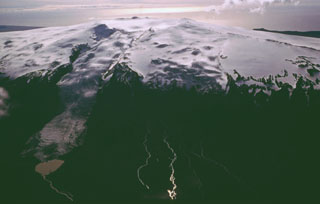Report on Eyjafjallajokull (Iceland) — 12 May-18 May 2010
Smithsonian Institution / US Geological Survey
Weekly Volcanic Activity Report, 12 May-18 May 2010
Managing Editor: Sally Sennert.
Please cite this report as:
Global Volcanism Program, 2010. Report on Eyjafjallajokull (Iceland) (Sennert, S, ed.). Weekly Volcanic Activity Report, 12 May-18 May 2010. Smithsonian Institution and US Geological Survey.
Eyjafjallajokull
Iceland
63.633°N, 19.633°W; summit elev. 1651 m
All times are local (unless otherwise noted)
The Institute of Earth Sciences at the Nordic Volcanological Center (NVC) reported that during 12-18 May the eruption from Eyjafjallajökull continued to produce ash plumes from the summit vent. Based on analyses of imagery from weather satellites, scientific overflights, and pilot reports, gray ash plumes rose to altitudes of 4-9 km (13,100-29,500 ft) a.s.l. and drifted mainly ESE, SE, and S. Plumes drifted W and SW during 14-15 May, and NE and N on 18 May. Ashfall was reported in multiple areas, as far away as 40 km SE and SW, over 50 km SSE, and in Reykjavík 125 km NW. The meltwater discharge at Gígjökull glacier was low, and deformation measurements indicated subsidence. According to news reports airports in parts of multiple European countries including England, Scotland, and Ireland were closed at times during 16-17 May.
Geological Summary. Eyjafjallajökull (also known as Eyjafjöll) is located west of Katla volcano. It consists of an elongated ice-covered stratovolcano with a 2.5-km-wide summit caldera. Fissure-fed lava flows occur on both the E and W flanks, but are more prominent on the western side. Although the volcano has erupted during historical time, it has been less active than other volcanoes of Iceland's eastern volcanic zone, and relatively few Holocene lava flows are known. An intrusion beneath the S flank from July-December 1999 was accompanied by increased seismic activity. The last historical activity prior to an eruption in 2010 produced intermediate-to-silicic tephra from the central caldera during December 1821 to January 1823.
Sources: Institute of Earth Sciences, BBC News

